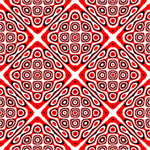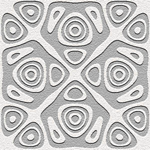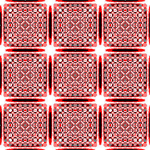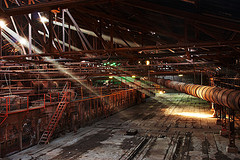It’s not that often (actually, it’s pretty much never) that your favourite live act of all times plays two shows literally across the street from where you live. Here’s my capsule review of the first show. (Stay tuned for Take 2, tomorrow night.)
First of all, I’ve never seen them in as small a venue as the Hummingbird (or the O’Keefe Centre for you old fogies). It suited them. The human scale was a nice change from the last show at the SkyDome. This time out, they seemed a lot more like a rock band and a lot less like a super-human machine. Their perfectionism can occassionally be painful, but this time they were pleasantly less rehearsed.
And more relaxed. Thom Yorke actually laughed out loud. Several times. At the audience being goofy. At himself, even—for completely flubbing the start of a song. Most Toronto fans still remember the tantrum he threw over forgetting the lyrics to Talk Show Host at Maple Leaf Gardens a few years ago.
The crowd was…enthusiastic. To the point that Yorke had to ask the audience to settle down so he could sing Exit Music. It was pretty funny listening to the crowd shushing and yelling at each other to shut up. Everyone was on their feet the entire night, and I’ve heard less cheering volume from much larger crowds.
As for the music…well, I don’t have a good enough memory to give a full set list. They opened with You And Whose Army, followed by National Anthem and Morning Bell. I sorta lost track after that. There were a lot of new songs, none of whose titles I can tell you, but several of them were great ensemble tunes. Jonny Greenwood is my guitar hero, so the feedback frenzy on Airbag was highly appreciated, as were those lovely god-awful crunches on Morning Bell. Jonny seemed a bit restrained tonight. He had some equipment problems, but made up for it by playing his guitar like a cello (yeah, with a bow) on Pyramid Song. Some of the other things he did with his guitar I can’t even describe. :-} Thom Yorke’s voice was in fine form as usual. For the first time ever, he played a drum kit along with Phil on one of the new songs. And his crazy stage dancing gets better every year…
They did a lot of old standby live favourites, as well as some odd ones, like a hyped up version of The Gloaming, and the ballad How To Disappear Completely. At least one old tune they rarely play, Street Spirit, was a 12-string treat. About the only thing I regret not hearing was My Iron Lung, because I love Jonny going wild on that one. They did two encores and closed with Everything In It’s Right Place. I’ve heard them do that tune much better, but it’s still a great way to end a show.
Well, I’m looking forward to doing that all over again tomorrow night. If they follow the pattern of the previous shows in Boston and Philadelphia, the set list will be completely different, and there should be fewer equipment glitches. If you’ve got a ticket, you’re gonna love it.







